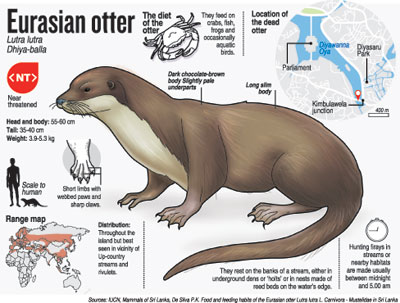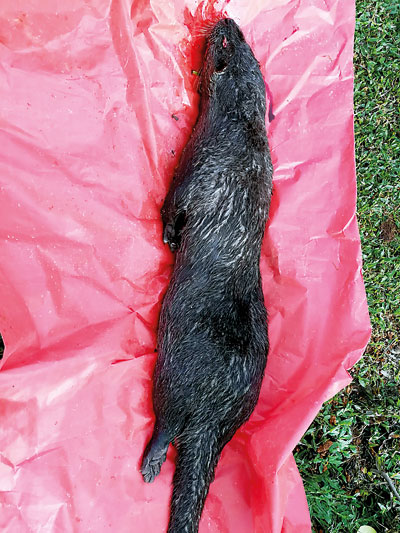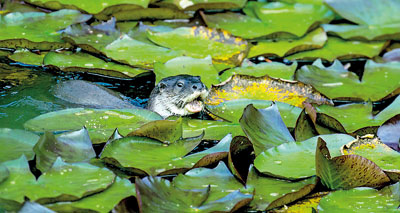News
Calls to protect Colombo’s urban wildlife as dead otter discovered near Parliament
World Otter Day falls on Wednesday (May 30); but an unfortunate otter inhabiting the marshes of Kotte, close to Parliament, did not live to see this day.
Environmentalists have asked motorists not to speed on the roads adjacent to urban marshland after the carcass of an otter was discovered close to the Parliament vehicle park and jogging track at the Kimbulawela junction recently.
Naturalist Rukmal Rathnayake who was one of the first to spot the dead mammal around 6.30 a.m. on May 19 said, “The otter was a well grown healthy female. There was blood on its body indicating it was hit by a speeding vehicle at night.”
Otters are known to inhabit the Kotte marshes and the nearby Thalangama lake and otter scats and paw marks have been sighted on the area’s muddy banks, but this shy, mainly nocturnal animal has never been spotted in this urban area. Sandun Bandara, Land Reclamation and Development Corporation’s Environmental Officer said that the otter that met her untimely death may have been inhabiting the Diyasaru Park.
Known as ‘dhiya balla’ in Sinhala the otter is a semi aquatic carnivorous mammal. There are 13 different species of otters found worldwide and the one found here is the eurasian otter, scientifically known as Lutra lutra.

No World Otter Day for her: The dead otter found close to Parliament
The eurasian otter has been categorised as ‘vulnerable to extinct’ by the National Red List of Threatened Fauna; but amazingly these elusive mammals still survive on the fringes of an urban city like Colombo.
Chair of the Otter Specialist Group of the International Union for Conservation of Nature (IUCN) Prof. Padma de Silva who has been studying the distribution of otters in Sri Lanka since 1988 said during the day these shy mammals are found in dense thickets of bush or fern close to water bodies. Pawmarks on streamside mud or droppings beside water bodies are the first signs of their presence. She said although Sri Lanka has a healthy population of otters, they were facing threats due to the ever increasing loss of wetland habitat.
Experts said incidents of otters being killed in road accidents have been recorded occasionally. In 2014, a dead otter was reported by Kithsiri Almeida in Puttalam while another one was reported in Udawalawe. However, they pointed out that the number of otters killed in road accidents could be higher as their carcasses are often mistakenly identified as civet or mongoose.
They said it was important to have over passes or under passes especially in urban wetland areas, known to be inhabited by otters and other wildlife, as they do in other countries, so that these animals could cross the road safely.
The experts also said it was important to protect the wildlife found in the remaining marshy areas in the outskirts of Colombo in Kotte, Thalawathugoda, and Kimbulawela. They said these areas still have quite a population of urban wildlife including rare nocturnal creatures such as the otter and fishing cat. Pointing out that although it was tempting to speed on these stretches of roads, especially at night, they urged motorists to be mindful when driving in these wetland areas and protect the urban wildlife that Colombo is still blessed with.
| Otter facts | |
| With webbed feet and slender body; the otter’s body is well streamlined for a life in the water. Otters are supreme swimmers and are called ‘seals of freshwater’ says Asoka Yapa in his book ‘Mammals of Sri Lanka’.  An otter in Horton Plains. Pic by Rajiv Welikala Otters are known to submerge themselves in water for five to eight minutes. They are also known to slow down their heart rate, so that they need less oxygen while underwater. An otter has two layers of fur: a dense undercoat that traps air and a topcoat of long, waterproof guard hairs that helps it to stay dry. Their main diet is fish, but the Otter also has cravings for crustaceans such as fresh water crabs. Prof. De Silva points out that they are opportunistic feeders. An otter’s rounded nose has whiskers above the lips and it is said that these can detect water current changes as well as the presence of prey or potential predators lurking in the water. |

